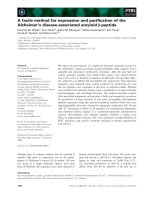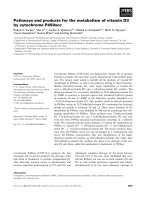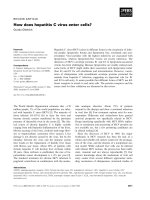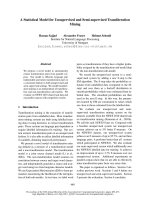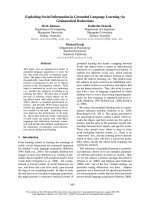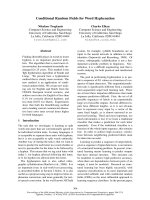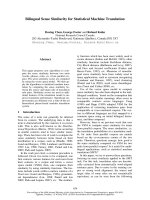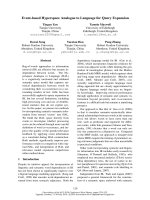Tài liệu Báo cáo khoa học: "Exploiting Non-local Features for Spoken Language Understanding" pptx
Bạn đang xem bản rút gọn của tài liệu. Xem và tải ngay bản đầy đủ của tài liệu tại đây (398.37 KB, 8 trang )
Proceedings of the COLING/ACL 2006 Main Conference Poster Sessions, pages 412–419,
Sydney, July 2006.
c
2006 Association for Computational Linguistics
Exploiting Non-local Features for Spoken Language Understanding
Minwoo Jeong and Gary Geunbae Lee
Department of Computer Science & Engineering
Pohang University of Science and Technology,
San 31 Hyoja-dong, Nam-gu
Pohang 790-784, Korea
{stardust,gblee}@postech.ac.kr
Abstract
In this paper, we exploit non-local fea-
tures as an estimate of long-distance de-
pendencies to improve performance on the
statistical spoken language understanding
(SLU) problem. The statistical natural
language parsers trained on text perform
unreliably to encode non-local informa-
tion on spoken language. An alternative
method we propose is to use trigger pairs
that are automatically extracted by a fea-
ture induction algorithm. We describe a
light version of the inducer in which a sim-
ple modification is efficient and success-
ful. We evaluate our method on an SLU
task and show an error reduction of up to
27% over the base local model.
1 Introduction
For most sequential labeling problems in natural
language processing (NLP), a decision is made
based on local information. However, processing
that relies on the Markovian assumption cannot
represent higher-order dependencies. This long-
distance dependency problem has been considered
at length in computational linguistics. It is the key
limitation in bettering sequential models in vari-
ous natural language tasks. Thus, we need new
methods to import non-local information into se-
quential models.
There are two types of method for using non-
local information. One is to add edges to structure
to allow higher-order dependencies and another is
to add features (or observable variables) to encode
the non-locality. An additional consistent edge of
a linear-chain conditional random field (CRF) ex-
plicitly models the dependencies between distant
occurrences of similar words (Sutton and McCal-
lum, 2004; Finkel et al., 2005). However, this
approach requires additional time complexity in
inference/learning time and it is only suitable for
representing constraints by enforcing label consis-
tency. We wish to identify ambiguous labels with
more general dependency without additional time
cost in inference/learning time.
Another approach to modeling non-locality is
to use observational features which can capture
non-local information. Traditionally, many sys-
tems prefer to use a syntactic parser. In a language
understanding task, the head word dependencies
or parse tree path are successfully applied to learn
and predict semantic roles, especially those with
ambiguous labels (Gildea and Jurafsky, 2002). Al-
though the power of syntactic structure is impres-
sive, using the parser-based feature fails to encode
correct global information because of the low ac-
curacy of a modern parser. Furthermore the inac-
curate result of parsing is more serious in a spoken
language understanding (SLU) task. In contrast
to written language, spoken language loses much
information including grammar, structure or mor-
phology and contains some errors in automatically
recognized speech.
To solve the above problems, we present one
method to exploit non-local information – the trig-
ger feature. In this paper, we incorporate trig-
ger pairs into a sequential model, a linear-chain
CRF. Then we describe an efficient algorithm to
extract the trigger feature from the training data it-
self. The framework for inducing trigger features
is based on the Kullback-Leibler divergence cri-
terion which measures the improvement of log-
likelihood on the current parameters by adding a
new feature (Pietra et al., 1997). To reduce the
cost of feature selection, we suggest a modified
412
version of an inducing algorithm which is quite ef-
ficient. We evaluate our method on an SLU task,
and demonstrate the improvements on both tran-
scripts and recognition outputs. On a real-world
problem, our modified version of a feature selec-
tion algorithm is very efficient for both perfor-
mance and time complexity.
2 Spoken Language Understanding as a
Sequential Labeling Problem
2.1 Spoken Language Understanding
The goal of SLU is to extract semantic mean-
ings from recognized utterances and to fill the
correct values into a semantic frame structure.
A semantic frame (or template) is a well-formed
and machine readable structure of extracted in-
formation consisting of slot/value pairs. An ex-
ample of such a reference frame is as follows.
<s> i wanna go from denver to new york on
november eighteenth </s>
FROMLOC.CITY NAME = denver
TOLOC.CITY NAME = new york
MONTH NAME = november
DAY NUMBER = eighteenth
This example from air travel data (CU-
Communicator corpus) was automatically gener-
ated by a Phoenix parser and manually corrected
(Pellom et al., 2000; He and Young, 2005). In this
example, the slot labels are two-level hierarchi-
cal; such as FROMLOC.CITY NAME. This hier-
archy differentiates the semantic frame extraction
problem from the named entity recognition (NER)
problem.
Regardless of the fact that there are some
differences between SLU and NER, we can
still apply well-known techniques used in NER
to an SLU problem. Following (Ramshaw
and Marcus, 1995), the slot labels are drawn
from a set of classes constructed by extending
each label by three additional symbols, Begin-
ning/Inside/Outside (B/I/O). A two-level hierar-
chical slot can be considered as an integrated flat-
tened slot. For example, FROMLOC.CITY NAME
and TOLOC.CITY NAME are different on this slot
definition scheme.
Now, we can formalize the SLU prob-
lem as a sequential labeling problem, y
∗
=
arg max
y
P (y |x). In this case, input word se-
quences x are not only lexical strings, but also
multiple linguistic features. To extract semantic
frames from utterance inputs, we use a linear-
chain CRF model; a model that assigns a joint
probability distribution over labels which is con-
ditional on the input sequences, where the distri-
bution respects the independent relations encoded
in a graph (Lafferty et al., 2001).
A linear-chain CRF is defined as follows. Let
G be an undirected model over sets of random
variables x and y. The graph G with parameters
Λ = {λ, . . .} defines a conditional probability for
a state (or label) sequence y = y
1
, . . . , y
T
, given
an input x = x
1
, . . . , x
T
, to be
P
Λ
(y|x) =
1
Z
x
exp
T
t=1
k
λ
k
f
k
(y
t−1
, y
t
, x, t)
where Z
x
is the normalization factor that makes
the probability of all state sequences sum to one.
f
k
(y
t−1
, y
t
, x, t) is an arbitrary linguistic feature
function which is often binary-valued in NLP
tasks. λ
k
is a trained parameter associated with
feature f
k
. The feature functions can encode any
aspect of a state transition, y
t−1
→ y
t
, and the
observation (a set of observable features), x, cen-
tered at the current time, t. Large positive val-
ues for λ
k
indicate a preference for such an event,
while large negative values make the event un-
likely.
Parameter estimation of a linear-chain CRF is
typically performed by conditional maximum log-
likelihood. To avoid overfitting, the 2-norm reg-
ularization is applied to penalize on weight vec-
tor whose norm is too large. We used a limited
memory version of the quasi-Newton method (L-
BFGS) to optimize this objective function. The
L-BFGS method converges super-linearly to the
solution, so it can be an efficient optimization
technique on large-scale NLP problems (Sha and
Pereira, 2003).
A linear-chain CRF has been previously applied
to obtain promising results in various natural lan-
guage tasks, but the linear-chain structure is defi-
cient in modeling long-distance dependencies be-
cause of its limited structure (n-th order Markov
chains).
2.2 Long-distance Dependency in Spoken
Language Understanding
In most sequential supervised learning prob-
lems including SLU, the feature function
f
k
(y
t−1
, y
t
, x
t
, t) indicates only local information
413
for practical reasons. With sufficient local context
(e.g. a sliding window of width 5), inference and
learning are both efficient.
However, if we only use local features, then
we cannot model long-distance dependencies.
Thus, we should incorporate non-local infor-
mation into the model. For example, figure
1 shows the long-distance dependency problem
in an SLU task. The same two word to-
kens “dec.” should be classified differently,
DEPART.MONTH and RETURN.MONTH. The
dotted line boxes represent local information at the
current decision point (“dec.”), but they are ex-
actly the same in two distinct examples. More-
over, the two states share the same previous
sequence (O, O, FROMLOC.CITY NAME-B,
O, TOLOC.CITY NAME-B, O). If we cannot
obtain higher-order dependencies such as “fly”
and “return,” then the linear-chain CRF cannot
classify the correct labels between the two same
tokens. To solve this problem, we propose an ap-
proach to exploit non-local information in the next
section.
3 Incorporating Non-local Information
3.1 Using Trigger Features
To exploit non-local information to sequential la-
beling for a statistical SLU, we can use two ap-
proaches; a syntactic parser-based and a data-
driven approach. Traditionally, information ex-
traction and language understanding fields have
usually used a syntactic parser to encode global
information (e.g. parse tree path, governing cat-
egory, or head word) over a local model. In a se-
mantic role labeling task, the syntax and semantics
are correlated with each other (Gildea and Juraf-
sky, 2002), that is, the global structure of the sen-
tence is useful for identifying ambiguous semantic
roles. However the problem is the poor accuracy
of the syntactic parser with this type of feature. In
addition, recognized utterances are erroneous and
the spoken language has no capital letters, no ad-
ditional symbols, and sometimes no grammar, so
it is difficult to use a parser in an SLU problem.
Another solution is a data-driven method, which
uses statistics to find features that are approxi-
mately modeling long-distance dependencies. The
simplest way is to use identical words in history or
lexical co-occurrence, but we wish to use a more
general tool; triggering. The trigger word pairs
are introduced by (Rosenfeld, 1994). A trigger
pair is the basic element for extracting informa-
tion from the long-distance document history. In
language modeling, n-gram based on the Marko-
vian assumption cannot represent higher-order de-
pendencies, but it can automatically extract trigger
word pairs from data. The pair (A → B) means
that word A and B are significantly correlated, that
is, when A occurs in the document, it triggers B,
causing its probability estimate to change.
To select reasonable pairs from arbitrary word
pairs, (Rosenfeld, 1994) used averaged mutual in-
formation (MI). In this scheme, the MI score of
one pair is MI(A; B) =
P (A, B) log
P (B|A)
P (B)
+ P (A,
¯
B) log
P (
¯
B|A)
P (
¯
B)
+
P (
¯
A, B) log
P (B|
¯
A)
P (
¯
B)
+ P (
¯
A,
¯
B) log
P (
¯
B|
¯
A)
P (
¯
B)
.
Using the MI criterion, we can select corre-
lated word pairs. For example, the trigger pair
(dec.→return) was extracted with score 0.001179
in the training data
1
. This trigger word pair can
represent long-distance dependency and provide a
cue to identify ambiguous classes. The MI ap-
proach, however, considers only lexical colloca-
tion without reference labels y, and MI based se-
lection tends to excessively select the irrelevant
triggers. Recall that our goal is to find the signif-
icantly correlated trigger pairs which improve the
model. Therefore, we use a more appropriate se-
lection method for sequential supervised learning.
3.2 Selecting Trigger Feature
We present another approach to extract relevant
triggers and exploit them in a linear-chain CRF.
Our approach is based on an automatic feature in-
duction algorithm, which is a novel method to se-
lect a feature in an exponential model (Pietra et al.,
1997; McCallum, 2003). We follow McCallum’s
work which is an efficient method to induce fea-
tures in a linear-chain CRF model. Following the
framework of feature inducing, we start the algo-
rithm with an empty set, and iteratively increase
the bundle of features including local features and
trigger features. Our basic assumption, however,
is that the local information should be included
because the local features are the basis of the de-
cision to identify the classes, and they reduce the
1
In our experiment, the pair (dec.→fly) cannot be selected
because this MI score is too low. However, the trigger pair is
a binary type feature, so the pair (dec.→return) is enough to
classify the two cases in the previous example.
414
1999dec.onchicagotodenverfromfly
10th
1999dec.onchicagotodenverfrom
10threturn
DEPART.MONTH
RETURN.MONTH
Figure 1: An example of a long-distance dependency problem in spoken language understanding. In
this case, a word token “dec.” with local feature set (dotted line box) is ambiguous for determining the
correct label (DEPART.MONTH or RETURN.MONTH).
mismatch between training and testing tasks. Fur-
thermore, this assumption leads us to faster train-
ing in the inducing procedure because we can only
consider additional trigger features.
Now, we start the inducing process with local
features rather than an empty set. After training
the base model Λ
(0)
, we should calculate the gains,
which measure the effect of adding a trigger fea-
ture, based on the local model parameter Λ
(0)
. The
gain of the trigger feature is defined as the im-
provement in log-likelihood of the current model
Λ
(i)
at the i-th iteration according to the following
formula:
ˆ
G
Λ
(i)
(g) = max
µ
G
Λ
(i)
(g, µ)
= max
µ
L
Λ
(i)
+g,µ
− L
Λ
(i)
where µ is a parameter of a trigger feature to
be found and g is a corresponding trigger feature
function. The optimal value of µ can be calculated
by Newton’s method.
By adding a new candidate trigger, the equation
of the linear-chain CRF model is changed to an
additional feature model as P
Λ
(i)
+g,µ
(y|x) =
P
Λ
(i)
(y|x) exp
T
t=1
µg(y
t−1
, y
t
, x, t)
Z
x
(Λ
(i)
, g, µ)
.
Note that Z
x
(Λ
(i)
, g, µ) is the marginal sum over
all states of y
. Following (Pietra et al., 1997; Mc-
Callum, 2003), the mean field approximation and
agglomerated features allows us to treat the above
calculation as the independent inference problem
rather than sequential inference. We can evaluate
the probability of state y with an adding trigger
pair given observation x separately as follows.
P
Λ
(i)
+g,µ
(y|x, t) =
P
Λ
(i)
(y|x, t) exp (µg(y
t
, x, t))
Z
x
(Λ
(i)
, g, µ)
Here, we introduce a second approximation. We
use the individual inference problem over the un-
structured maximum entropy (ME) model whose
state variable is independent from other states in
history. The background of our approximation is
that the state independent problem of CRF can
be relaxed to ME inference problem without the
state-structured model. In the result, we calculate
the gain of candidate triggers, and select trigger
features over a light ME model instead of a huge
computational CRF model
2
.
We can efficiently assess many candidate trig-
ger features in parallel by assuming that the old
features remain fixed while estimating the gain.
The gain of trigger features can be calculated on
the old model that is trained with the local and
added trigger pairs in previous iterations. Rather
than summing over all training instances, we only
need to use the mislabeled N tokens by the cur-
rent parameter Λ
(i)
(McCallum, 2003). From mis-
classified instances, we generate the candidates of
trigger pairs, that is, all pairs of current words and
others within the sentence. With the candidate fea-
ture set, the gain is
ˆ
G
Λ
(i)
(g) = N ˆµ
˜
E[g]
−
N
j=1
log (E
Λ
(i)
[exp(ˆµg)|x
j
]) −
ˆµ
2
2σ
2
.
Using the estimated gains, we can select a small
portion of all candidates, and retrain the model
with selected features. We iteratively perform the
selection algorithm with some stop conditions (ex-
cess of maximum iteration or no added feature up
to the gain threshold). The outline of the induction
2
The ME model cannot represent the sequential structure
and the resulting model is different from CRF. Nevertheless,
we empirically prove that the effect of additional trigger fea-
tures on both ME and approximated CRF (without regarding
edge-state) are similar (see the experiment section).
415
Algorithm InduceLearn(x,y)
triggers ← {ε} and i ← 0
while |pairs| > 0 and i < maxiter do
Λ
(i)
← TrainME(x, y)
P (y
e
|x
e
) ← Evaluate(x, y, Λ
(i)
)
c ← MakeCandidate(x
e
)
G
Λ
(i)
← EstimateGain(c, P (y
e
|x
e
))
pairs ← SelectTrigger(c, G
Λ
(i)
)
x ← UpdateObs(x, pairs)
triggers ← triggers ∪pairs and i ← i + 1
end while
Λ
(i+1)
← TrainCRF(x, y)
return Λ
(i+1)
Figure 2: Outline of trigger feature induction al-
gorithm
algorithms is described in figure 2. In the next sec-
tion, we empirically prove the effectiveness of our
algorithm.
The trigger pairs introduced by (Rosenfeld,
1994) are just word pairs. Here, we can gen-
eralize the trigger pairs to any arbitrary pairs of
features. For example, the feature pair (of→B-
PP) is useful in deciding the correct answer
PERIOD OF DAY-I in “in the middle of the day.”
Without constraints on generating the pairs (e.g.
at most 3 distant tokens), the candidates can be
arbitrary conjunctions of features
3
. Therefore we
can explore any features including local conjunc-
tion or non-local singleton features in a uniform
framework.
4 Experiments
4.1 Experimental Setup
We evaluate our method on the CU-Communicator
corpus. It consists of 13,983 utterances. The se-
mantic categories correspond to city names, time-
related information, airlines and other miscella-
neous entities. The semantic labels are automat-
ically generated by a Phoenix parser and manually
corrected. In the data set, the semantic category
has a two-level hierarchy: 31 first level classes
and 7 second level classes, for a total of 62 class
combinations. The data set is 630k words with
29k entities. Roughly half of the entities are time-
related information, a quarter of the entities are
3
In our experiment, we do not consider the local conjunc-
tions because we wish to capture the effect of long-distance
entities.
city names, a tenth are state and country names,
and a fifth are airline and airport names. For
the second level hierarchy, approximately three
quarters of the entities are “NONE”, a tenth are
“TOLOC”, a tenth are “FROMLOC”, and the re-
maining are “RETURN”, “DEPERT”, “ARRIVE”,
and “STOPLOC.”
For spoken inputs, we used the open source
speech recognizer Sphinx2. We trained the recog-
nizer with only the domain-specific speech corpus.
The reported accuracy for Sphinx2 speech recog-
nition is about 85%, but the accuracy of our speech
recognizer is 76.27%; we used only a subset of the
data without tuning and the sentences of this sub-
set are longer and more complex than those of the
removed ones, most of which are single-word re-
sponses.
All of our results have averaged over 5-fold
cross validation with an 80/20 split of the data.
As it is standard, we compute precision and re-
call, which are evaluated on a per-entity basis and
combined into a micro-averaged F1 score (F1 =
2PR/(P+R)).
A final model (a first-order linear chain CRF)
is trained for 100 iterations with a Gaussian prior
variance of 20, and 200 or fewer trigger features
(down to a gain threshold of 1.0) for each round of
inducing iteration (100 iterations of L-BFGS for
the ME inducer and 10∼20 iterations of L-BFGS
for the CRF inducer). All experiments are imple-
mented in C++ and executed on Linux with XEON
2.8 GHz dual processors and 2.0 Gbyte of main
memory.
4.2 Empirical Results
We list the feature templates used by our experi-
ment in figure 3. For local features, we use the
indicators for specific words at location i, or lo-
cations within five words of i (−2, −1, 0, +1, +2
words on current position i). We also use the part-
of-speech (POS) tags and phrase labels with par-
tial parsing. Like words, the two basic linguis-
tic features are located within five tokens. For
comparison, we exploit the two groups of non-
local syntax parser-based features; we use Collins
parser and extract this type of features from the
parse trees. The first consists of the head word
and POS-tag of the head word. The second group
includes governing category and parse tree paths
introduced by semantic role labeling (Gildea and
Jurafsky, 2002). Following the previous studies
416
Local feature templates
-lexical words
-part-of-speech (POS) tags
-phrase chunk labels
Grammar-based feature templates
-head word / POS-tag
-parse tree path and governing category
Trigger feature templates
-word pairs (w
i
→ w
j
), |i − j| > 2
-feature pairs between words, POS-tags, and
chunk labels (f
i
→ f
j
), |i − j| > 2
-null pairs (ε → w
j
)
Figure 3: Feature templates
of semantic role labeling, the parse tree path im-
proves the classification performance of semantic
role labeling. Finally, we use the trigger pairs that
are automatically extracted from the training data.
Avoiding the overlap of local features, we add the
constraint |i −j| > 2 for the target word w
j
. Note
that null pairs are equivalent to long-distance sin-
gleton word features w
j
.
To compute feature performance, we begin with
word features and iteratively add them one-by-one
so that we achieve the best performance. Table 1
shows the empirical results of local features, syn-
tactic parser-based features, and trigger features
respectively. The two F1 scores for text tran-
scripts (Text) and outputs recognized by an au-
tomatic speech recognizer (ASR) are listed. We
achieved F1 scores of 94.79 and 71.79 for Text and
ASR inputs using only word features. The perfor-
mance is decreased by adding the additional local
features (POS-tags and chunk labels) because the
pre-processor brings more errors to the system for
spoken dialog.
The parser-based and trigger features are added
to two baselines: word only and all local features.
The result shows that the trigger feature is more
robust to an SLU task than the features generated
from the syntactic parser. The parse tree path and
governing category show a small improvement of
performance over local features, but it is rather in-
significant (word vs. word+path, McNemar’s test
(Gillick and Cox, 1989); p = 0.022). In contrast,
the trigger features significantly improve the per-
formance of the system for both Text and ASR
inputs. The differences between the trigger and
the others are statistically significant (McNemar’s
test; p < 0.001 for both Text and ASR).
Table 1: The result of local features, parser-based
features and trigger features
Feature set F1 (Text) F1 (ASR)
word (w) 94.79 71.79
w + POStag (p) 94.57 71.61
w + chunk (c) 94.70 71.64
local (w+p+c) 94.41 71.60
w + head (h) 94.55 71.76
w + path (t) 95.07 72.17
w + h + t 94.84 72.09
local + head (h) 94.17 71.39
local + path (t) 94.80 71.89
local + h + t 94.51 71.67
w + trigger 96.18 72.95
local + trigger 96.04 72.72
Next, we compared the two trigger selection
methods; mutual information (MI) and feature in-
duction (FI). Table 2 shows the experimental re-
sults of the comparison between MI and FI ap-
proaches (with the local feature set; w+p+c). For
the MI-based approach, we should calculate an av-
eraged MI for each word pair appearing in a sen-
tence and cut the unreliable pairs (down to thresh-
old of 0.0001) before training the model. In con-
trast, the FI-based approach selects reliable trig-
gers which should improve the model in train-
ing time. Our method based on the feature in-
duction algorithm outperforms simple MI-based
methods. Fewer features are selected by FI, that
is, our method prunes the event pairs which are
highly correlated, but not relevant to models. The
extended feature trigger (f
i
→ f
j
) and null trig-
gers (ε → w
j
) improve the performance over word
trigger pairs (w
i
→ w
j
), but they are not statisti-
cally significant (vs. (f
i
→ f
j
); p = 0.749, vs.
({ε, w
i
} → w
j
); p = 0.294). Nevertheless, the
null pairs are effective in reducing the size of trig-
ger features.
Figure 4 shows a sample of triggers selected by
MI and FI approaches. For example, the trigger
“morning → return” is ranked in first of FI but
66th of MI. Moreover, the top 5 pairs of MI are
not meaningful, that is, MI selects many functional
word pairs. The MI approach considers only lexi-
cal collocation without reference labels, so the FI
method is more appropriate to sequential super-
vised learning.
Finally, we wish to justify that our modified
417
Table 2: Result of the trigger selection methods
Method Avg. # triggers F1 (Text) F1 (ASR) McNemar’s test (vs. MI)
MI (w
i
→ w
j
) 1,713 95.20 72.12 -
FI (w
i
→ w
j
) 702 96.04 72.72 p < 0.001
FI (f
i
→ f
j
) 805 96.04 72.76 p < 0.001
FI ({ε, w
i
} → w
j
) 545 96.14 72.80 p < 0.001
Mutual Information Feature Induction
[1] from→like [1] morning→return
[2] on→to [2] morning→on
[3] to→i [3] morning→to
[4] on→from [4] afternoon→on
[5] from→i [5] afternoon→return
[41] afternoon→return [6] afternoon→to
[66] morning→return [15] morning→leaving
[89] morning→leaving [349] december→return
[1738] london→fly [608] illinois→airport
Figure 4: A sample of triggers extracted by two
methods
version of an inducing algorithm is efficient and
maintains performance without any drawbacks.
We proposed two approximations: starting with
local features (Approx. 1) and using an unstruc-
tured model on the selection stage (Approx. 2),
Table 3 shows the results of variant versions of
the algorithm. Surprisingly, the selection crite-
rion based on ME (the unstructured model) is bet-
ter than CRF (the structured model) not only for
time cost but also for the performance on our ex-
periment
4
. This result shows that local informa-
tion provides the fundamental decision clues. Our
modification of the algorithm to induce features
for CRF is sufficiently fast for practical usage.
5 Related Work and Discussion
The most relevant previous work is (He and
Young, 2005) who describes an generative ap-
proach – hidden vector state (HVS) model. They
used 1,178 test utterances with 18 classes for 1st
level label, and published the resulting F1 score
of 88.07. Using the same test data and classes,
we achieved the 92.77 F1-performance, as well
4
In our analysis, 10∼20 iterations for each round of in-
ducing procedure are insufficient in optimizing the model in
CRF (empty) inducer. Thus, the resulting parameters are
under-fitted and selected features are infeasible. We need
more iteration to fit the parameters, but they require too much
learning time (> 1 day).
as 39% of error reduction compared to the previ-
ous result. Our system uses a discriminative ap-
proach, which directly models the conditional dis-
tribution, and it is sufficient for classification task.
To capture long-distance dependency, HVS uses a
context-free model, which increases the complex-
ity of models. In contrast, we use non-local trigger
features, which are relatively easy to use without
having additional complexity of models.
Trigger word pairs are introduced and success-
fully applied in a language modeling task. (Rosen-
feld, 1994) demonstrated that the trigger word
pairs improve the perplexity in ME-based lan-
guage models. Our method extends this idea to
sequential supervised learning problems. Our trig-
ger selection criterion is based on the automatic
feature inducing algorithm, and it allows us to gen-
eralize the arbitrary pairs of features.
Our method is based on two works of fea-
ture induction on an exponential model, (Pietra et
al., 1997) and (McCallum, 2003). Our induction
algorithm builds on McCallum’s method which
presents an efficient procedure to induce features
on CRF. (McCallum, 2003) suggested using only
the mislabeled events rather than the whole train-
ing events. This intuitional suggestion has offered
us fast training. We added two additional approx-
imations to reduce the time cost; 1) an inducing
procedure over a conditional non-structured infer-
ence problem rather than an approximated sequen-
tial inference problem, and 2) training with a local
feature set, which is the basic information to iden-
tify the labels.
In this paper, our approach describes how to
exploit non-local information to a SLU prob-
lem. The trigger features are more robust than
grammar-based features, and are easily extracted
from the data itself by using an efficient selection
algorithm.
418
Table 3: Comparison of variations in the induction algorithm (performed on one of the 5-fold validation
sets); columns are induction and total training time (h:m:s), number of trigger and total features, and
f-score on test data.
Inducer type Approx. Induction/total time # triggers/features F1 (Text) F1 (ASR)
CRF (empty) No approx. 3:55:01 / 5:27:13 682 / 2,693 90.23 67.60
CRF (local) Approx. 1 1:25:28 / 2:56:49 750 / 5,241 94.87 71.65
ME (empty) Approx. 2 20:57 / 1:54:22 618 / 2,080 94.85 71.46
ME (local) Approx. 1+2 6:30 / 1:36:14 608 / 5,099 95.17 71.81
6 Conclusion
We have presented a method to exploit non-local
information into a sequential supervised learning
task. In a real-world problem such as statistical
SLU, our model performs significantly better than
the traditional models which are based on syntac-
tic parser-based features. In comparing our se-
lection criterion, we find that the mutual informa-
tion tends to excessively select the triggers while
our feature induction algorithm alleviates this is-
sue. Furthermore, the modified version of the al-
gorithm is practically fast enough to maintain its
performance particularly when the local features
are offered by the starting position of the algo-
rithm.
In this paper, we have focused on a sequential
model such as a linear-chain CRF. However, our
method can also be naturally applied to arbitrary
structured models, thus the first alternative is to
combine our methods with a skip-chain CRF (Sut-
ton and McCallum, 2004). Applying and extend-
ing our approach to other natural language tasks
(which are difficult to apply a parser to) such as in-
formation extraction from e-mail data or biomed-
ical named entity recognition is a topic of future
work.
Acknowledgements
We thank three anonymous reviewers for helpful
comments. This research was supported by the
MIC (Ministry of Information and Communica-
tion), Korea, under the ITRC (Information Tech-
nology Research Center) support program super-
vised by the IITA (Institute of Information Tech-
nology Assessment). (IITA-2005-C1090-0501-
0018)
References
J. R. Finkel, T. Grenager, and C. Manning. 2005. In-
corporating non-local information into information
extraction systems by gibbs sampling. In Proceed-
ings of ACL’05, pages 363–370.
D. Gildea and D. Jurafsky. 2002. Automatic label-
ing of semantic roles. Computational Linguistics,
28(3):245–288.
L. Gillick and S. Cox. 1989. Some statistical issues in
the comparison of speech recognition algorithms. In
Proceedings of ICASSP, pages 532–535.
Y. He and S. Young. 2005. Semantic processing using
the hidden vector state model. Computer Speech &
Language, 19(1):85–106.
J. Lafferty, A. McCallum, and F. Pereira. 2001. Con-
ditional random fields: Probabilistic models for seg-
menting and labeling sequence data. In Proceedings
of ICML, pages 282–289.
A. McCallum. 2003. Efficiently inducing features of
conditional random fields. In Proceedings of UAI,
page 403.
B. L. Pellom, W. Ward, and S. S. Pradhan. 2000. The
cu communicator: An architecture for dialogue sys-
tems. In Proceedings of ICSLP.
S. Della Pietra, V. J. Della Pietra, and J. Lafferty. 1997.
Inducing features of random fields. IEEE Trans.
Pattern Anal. Mach. Intell, 19(4):380–393.
L. A. Ramshaw and M. P. Marcus. 1995. Text chunk-
ing using transformation-based learning. In 3rd
Workshop on Very Large Corpora, pages 82–94.
R. Rosenfeld. 1994. Adaptive statistical language
modeling: A maximum entropy approach. Tech-
nical report, School of Computer Science Carnegie
Mellon University.
F. Sha and F. Pereira. 2003. Shallow parsing
with conditional random fields. In Proceedings of
HLT/NAACL’03.
C. Sutton and A. McCallum. 2004. Collective segmen-
tation and labeling of distant entities in information
extraction. In ICML Workshop on Statistical Rela-
tional Learning.
419
